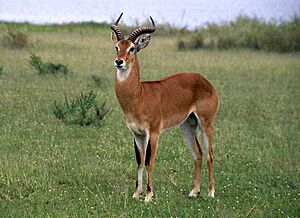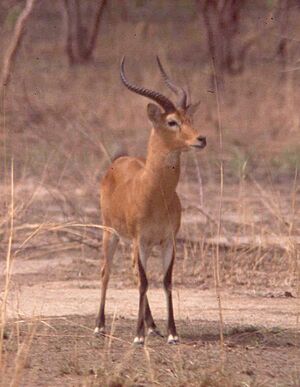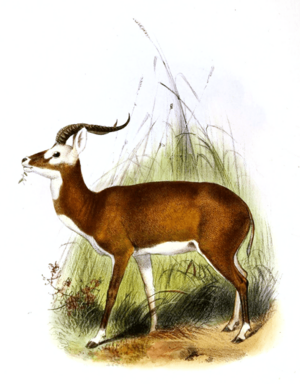Kob facts for kids
Quick facts for kids Kob |
|
|---|---|
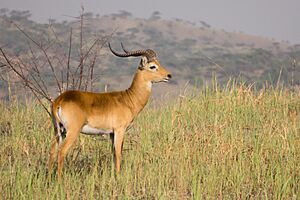 |
|
| Male At the Queen Elizabeth National Park |
|
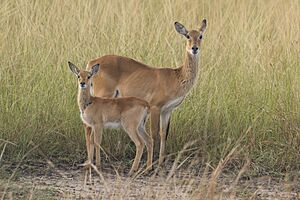 |
|
| Female and calf At the Semliki Wildlife Reserve both K. k. thomasi in Uganda |
|
| Conservation status | |
| Scientific classification | |
| Subspecies | |
|
|
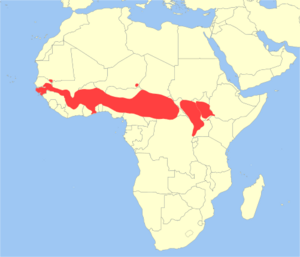 |
|
| Geographic range |
The kob (Kobus kob) is a type of antelope. You can find kobs in many parts of Central Africa, West Africa, and East Africa. They are related to other antelopes like reedbucks and waterbucks.
Kobs often live in wet areas like floodplains. They love to eat different kinds of grasses. Kobs are active during the day, but they rest when it gets too hot. They usually live in groups. These groups can be made up of females and their young, or just males. A group usually has between five and 40 kobs.
In eastern Africa, the Ugandan kob (Kobus kob thomasi) is very special. It even appears on the coat of arms of Uganda. Another type, the white-eared kob (Kobus kob leucotis), lives in South Sudan and Ethiopia. These kobs are known for their huge migrations.
Contents
What Kobs Look Like
Kobs look a bit like impalas, but they are built more strongly. Male kobs are bigger than females and have horns. Males are about 90–100 cm (3.0–3.3 ft) tall at the shoulder. They weigh around 94 kg (207 lb). Females are a bit smaller, about 82–92 cm (2.69–3.02 ft) tall. They weigh about 63 kg (139 lb).
Most kobs have a golden to reddish-brown coat. Their throat, the area around their eyes, and the inside of their ears are white. Their front legs have black markings. As male kobs get older, their fur often becomes darker.
The white-eared kob (K. k. leucotis) looks quite different. It lives in the Sudd region. Its coat is very dark, similar to a male Nile lechwe. However, it has a white throat. Both male and female kobs have special glands. These glands produce a yellow, waxy substance.
Where Kobs Live
Kobs live in many countries across Africa. You can find them in Benin, Burkina Faso, Cameroon, and the Central African Republic. They also live in Chad, Ivory Coast, Democratic Republic of the Congo, and Ethiopia. Other countries include Ghana, Guinea, Guinea Bissau, Mali, Mauritania, Niger, Nigeria, Senegal, South Sudan, Togo, and Uganda.
Sadly, kobs used to live in other places too. They were once found in Gambia, Kenya, Sierra Leone, Morocco, and Tanzania. But now, they are no longer found in those areas.
Kob Habitat and Food
Kobs are found in different parts of Africa. They prefer flat, open areas that are close to water. They need a steady climate to thrive. Kobs drink water every day and need fresh grass to eat. During rainy seasons, they like to stay in areas with short grasses.
Because they need water, kobs do not go far into dry areas. They move from one grazing spot to another as the seasons change. In areas that flood, they might travel hundreds of kilometers. During dry seasons, they may walk 10 kilometers or more to find water. Kobs enjoy eating certain types of grasses. These include Hyparrhenia, Brachiaria brizantha, Setaria gayanus, Chloris gayana, Echinochloa, and Digitaria species.
Kob Families and Social Life
Female kobs can live in very large groups, sometimes with thousands of animals. They move around more and are more social than male kobs. Females lead the daily trips to find water. Young kobs learn where to go from their mothers. In very large groups, females follow other females. Males also travel with these large groups. All-male groups can have hundreds of kobs. They follow the females during the dry season.
The way kobs organize their social lives can change. If there are not many kobs in an area, males set up their own territories. They do not travel much. Adult males try to find territories with the best habitat. These areas are usually where female kobs and their young live. Kob groups are always changing in size. Individuals move to find green plants. Other males, especially young ones, live in groups of bachelors. They are kept separate from the females by the territorial males.
In flooded areas, where many kobs live, about two-thirds of the males have territories. The other males live in groups of territories called leks. These leks are often smaller than a single territory. Lek areas are usually patches of short grass or bare ground. These spots are not good for food. They are mainly used by males for mating. About 8 or 9 out of every 10 females visit leks to find a mate.
Kobs usually live in smaller groups of 5 to 15 animals. But groups of over 40 kobs have been seen. Females and bachelor males live in large herds of up to 2000. They move through the leks. These leks are near good grass, waterholes, and common travel routes.
Male Ugandan kobs (K. k. thomasi) usually settle disagreements without fighting. They often just walk stiffly towards another male to make him leave. Males in leks do the same when they meet at their borders. White-eared kobs in leks fight more often. Ugandan kobs can sometimes get hurt or even die in fights. This happens especially when they are fighting for control of a territory. Fights usually involve males clashing their horns head-on. They push and twist each other. Sometimes, a male might attack from the side or behind.
In lek groups, the strongest males are in the center. There are usually three to seven males in the center of a lek. Their territories are very close together. These males get to mate with most of the females. Males in leks are replaced more often than males in regular territories. Most males can only stay in the center for a day or two, rarely up to a week. This is because there is a lot of competition. Also, males have to leave their territories to eat and drink. Males in the center try to eat during quiet times. But they still cannot get enough food and water. So, they eventually have to leave their leks. However, a male can get enough energy back after a week or two. Then, he might try to get his position back. At every lek, males are always waiting to take or retake a central spot. Males in traditional territories can stay for at least a year or two.
Reproduction and Life Cycle
Female kobs can have their first babies when they are about 13 to 14 months old. They have a cycle of 20 to 26 days until they become pregnant. Males in traditional territories and leks have different ways of attracting females. Males in traditional territories try to keep females in their area. Lek males try to do the same, but they usually do not succeed. They have to rely on showing off to attract females.
Kob courtship can be very short, sometimes just two minutes. Mating itself might only last a few seconds. At leks, a female might mate up to 20 times in one day with the central males. After being pregnant for about eight months, a female gives birth. She can become pregnant again 21 to 64 days later.
For their first month, baby kobs (calves) hide in thick plants. Mother and calf can recognize each other by their smell. As they get older, calves gather into groups called crèches. When they are three to four months old, the young kobs join the female herds. They stay with their mothers until they are six to seven months old. By then, they are weaned (no longer drinking milk). When they grow up, male kobs join bachelor groups.
Kob Conservation Status
The number of kobs has gone down because of hunting and human development. The Uganda kob (Kobus kob thomasi) disappeared from southwestern Kenya and northwestern Tanzania. This happened because human towns and farms grew. However, there are still many of these kobs in Murchison Falls National Park and Queen Elizabeth National Park in Uganda. They also live in Garamba National Park and Virunga National Park in the Democratic Republic of the Congo.
Buffon's kob (Kobus kob kob) is protected in several parks. These include Niokolo-Koba National Park in Senegal and Comoé National Park in Côte d'Ivoire. They are also found in Arly-Singou in Burkina Faso, Mole National Park and Bui National Park in Ghana. Other protected areas are Pendjari National Park in Benin, Waza National Park, Bénoué National Park, and Faro National Park in Cameroon. You can also find them in Zakouma National Park in Chad, and Manovo-Gounda St. Floris National Park and Dzanga Sangha Forest Reserve in the Central African Republic.
The white-eared kob (Kobus kob leucotis) was once thought to be almost extinct. This was due to the Second Sudanese Civil War (1983–2005). But surveys in 2007 and later showed that hundreds of thousands of them survived. These kobs, along with tiang and Mongalla gazelles, take part in one of the biggest animal migrations on Earth. About 1.2 million animals migrate together! The white-eared kob is protected in Boma National Park and Bandingilo National Park in South Sudan. They are also protected in Gambella National Park in Ethiopia.
See also



